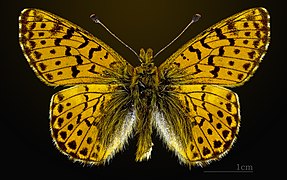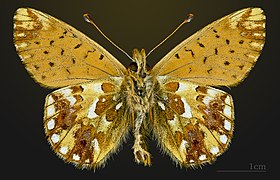Alpine mat mother-of-pearl butterfly
| Alpine mat mother-of-pearl butterfly | ||||||||||||
|---|---|---|---|---|---|---|---|---|---|---|---|---|

Alpine mat mother-of-pearl butterfly ( Boloria pales ) |
||||||||||||
| Systematics | ||||||||||||
|
||||||||||||
| Scientific name | ||||||||||||
| Boloria pales | ||||||||||||
| ( Denis & Schiffermüller , 1775) |
The alpine moth mother-of-pearl butterfly ( Boloria pales ) or high-alpine mother-of-pearl butterfly is a European high mountain butterfly ( butterfly ) from the family of the noble butterfly (Nymphalidae). The specific epithet is derived from Pales , a deity of the shepherds from Roman mythology .
features
butterfly
The wing tops of the moths, which have a wingspan of about 25 to 30 millimeters and relatively narrow forewings, usually glow orange-brown and are criss-crossed by a fine, black pattern consisting of points and lines. Slightly darkened or strongly melanistic moths are also less common . The strong rust-red underside of the hind wing is characteristic, which is very strong in this species and is only interrupted by a few irregular yellowish drawing elements.
Egg, caterpillar, pupa
The egg has a cone-like shape, is heavily ribbed and shimmers light pink. The caterpillars are black-brown in color, have a yellowish, brown interrupted back line as well as black, yellow-bordered rows of spots and short yellow-white bristles. The doll is brown-gray in color with dark markings and a squat shape.
Similar species
The alpine mat mother-of-pearl butterfly is similar to some other mother -of-pearl butterfly species , especially the following:
- Similar mother-of-pearl butterfly ( Boloria napaea ). The males are somewhat larger, while the females, which are also larger, are easy to distinguish because of their often purple-brown or green-brown color on the upper side and show a more yellow-green colored underside of the hind wings.
- Boloria graeca is a slightly larger species, the underside of the hind wing is lighter and more yellowish.
- High-moor mother-of-pearl butterfly ( Boloria aquilonaris ). The moths are more broadly winged with more rounded hind wings. The black markings are a bit more distinctive and stronger.
- Snakewort mother-of-pearl butterfly ( Boloria titania ). The drawing on the front is more prominent and somewhat darker, the underside of the hind wings more strongly colored rust-red.
- Alpine mother-of-pearl butterfly ( Boloria thore ). The species has much darker, merging drawing elements on the wing fronts.
- Lean-grass mother-of-pearl butterfly ( Boloria dia ). The moths are usually smaller and more strongly drawn.
- Meadowsweet mother-of-pearl butterfly ( Brenthis ino ). The moths are larger, have conspicuously rounded wings and a paler, less pronounced red markings on the back of the rear wing.
In order to be absolutely sure about the determination, specialists should be consulted.
distribution and habitat
The occurrence of the species extends in the European temperate high mountains from the Cantabrian Mountains and the Pyrenees over the Alps and the Apennines south-east to the High Dinarides, the Šar Planina and Korab Mountains , the Rila and Pirin as well as the South Carpathians , the Caucasus and Central Asia to western China . It can be found on alpine meadows at altitudes between 1500 and 3000 meters.
Way of life
The moths live in one generation from late June to August. They fly in a whirring flight over flowery high mountain meadows close to the ground. The caterpillars live polyphagous on low plants of the genera Viola , Polygonum and Plantago , but prefer violet species ( Viola ) and overwinter. In the Alps, only the long-tailed violet ( Viola calcarata ) is the food plant of the larvae. They pupate on or under stones.
Danger
The species occurs in Germany only in the Bavarian Alps , can be quite numerous in individual places and is listed on the Red List of Threatened Species in Category R (species with geographical restriction).
swell
Individual evidence
- ^ Arnold Spuler: The butterflies of Europe . tape 1 . E. Schweitzerbartsche Verlagbuchhandlung, Stuttgart 1908, p. 27 .
- ↑ Walter Forster, Theodor A. Wohlfahrt: The butterflies of Central Europe. Volume 2: Butterflies. (Rhopalocera and Hesperiidae). Franckh'sche Verlagshandlung, Stuttgart 1955, DNB 456642188 .
- ↑ Zoltan Varga 2014: Biogeography of the High-Mountain Lepidoptera of the Balkan Peninslua. Ecologia Montenegrina, 1 (3): 140-168
- ↑ Günter Ebert, Erwin Rennwald: The butterflies of Baden-Wuerttemberg Volume 1, butterflies I. Ulmer, Stuttgart 1993, ISBN 3-800-13451-9
- ↑ Federal Agency for Nature Conservation (Ed.): Red List of Endangered Animals in Germany. Landwirtschaftsverlag, Münster 1998, ISBN 978-3-896-24110-8
literature
- Walter Forster , Theodor A. Wohlfahrt : The butterflies of Central Europe. Volume 2: Butterflies. (Rhopalocera and Hesperiidae). Franckh'sche Verlagshandlung, Stuttgart 1955, DNB 456642188 .
Web links
- Lepiforum e. V. Taxonomy and Photos
- funet.fi distribution (English)
- www.schmetterlinge-deutschlands.de Endangerment
- Boloria (Boloria) pales at Fauna Europaea




